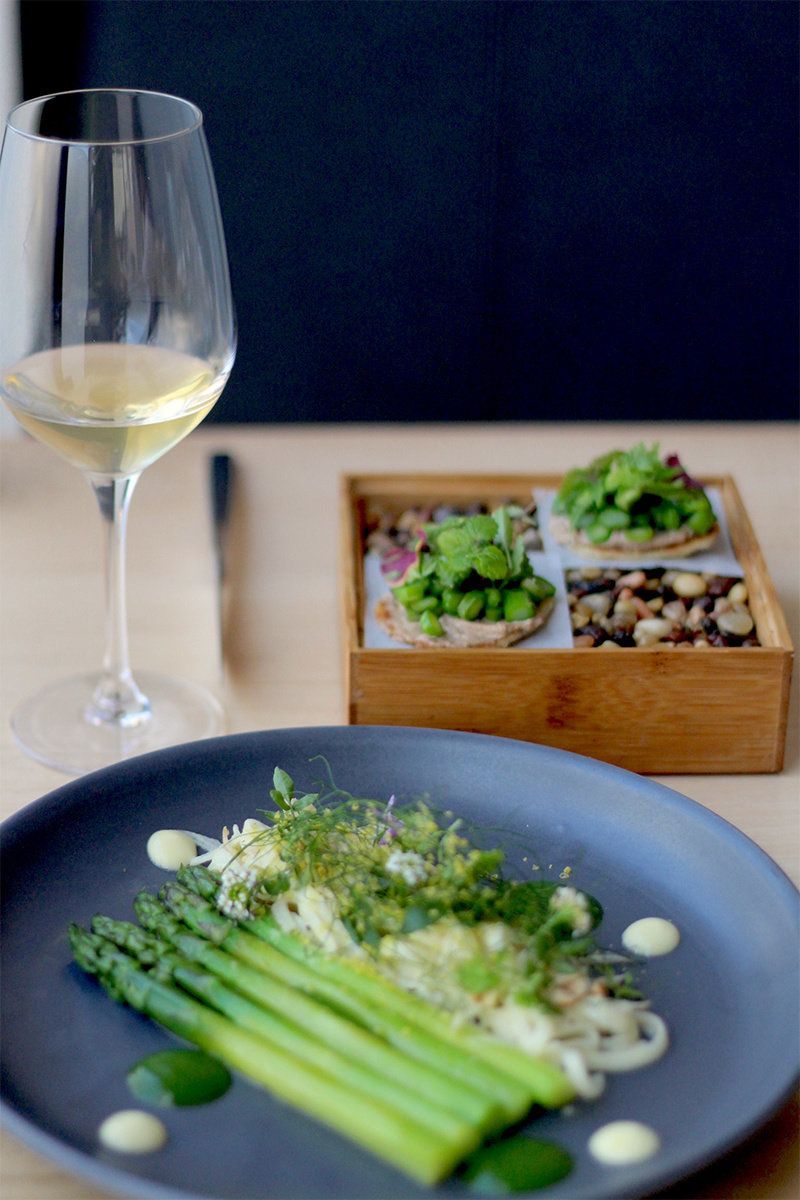Snyder paired a stony-saline Marmajuelo (a grape variety indigenous to the Canary Islands) with a dish of albacore crudo, harissa, sticky rice, sea beans, melon, whipped tofu, purslane, and licorice herb gelée.
(Nick Czap)
In 2014, after passing the Certified Sommelier exam, Snyder went to the Plumed Horse in Saratoga and worked as the assistant to the restaurant's wine director, Jeffrey Perisho, before moving on to Soif, a restaurant and wine bar in Santa Cruz whose eclectic list was then curated by John Locke and Alyssa Twelker, influential figures in a region whose winemakers are known for their whimsy and irreverence, and for eschewing typical blockbusters like cabernet and chardonnay in favor of lesser-known varieties and pure expressions of terroir. Snyder described the latter experience as "defining."
Between Soif and Commonwealth, Snyder worked as a sommelier at Lazy Bear, and then, in the summer of 2017, returned to the Santa Cruz area to work with Ryan Stirm, one of the region's new generation winemakers who she describes as "their own species of animal." It's a phrase one could just as easily apply to the wines at Commonwealth, which are made, by and large, by small producers in lesser-known regions, often from little-known grape varieties.
Take Ignios Orígenes's 2015 Marmajuelo, for instance, a varietal made from a grape indigenous to the Canary Islands. More tan than yellow, its aroma and flavor were slightly reminiscent of a very dry Madeira, with a smooth salinity and a pervasive sense of stone. "What I like about this wine is its cool earthiness," said Snyder, "a flavor that transports you to a volcanic island." The sensations were new, and in a way revelatory (it was the first time I'd had a wine from the Canaries) and made a kind of perfect sense with the corresponding dish—albacore crudo with harissa, sticky rice, sea beans, melon, whipped tofu, purslane, and licorice-herb gelée—mimicking the salty notes of the fish, the sea beans, and the purslane, while simultaneously tamping down the harissa's rather intense heat.
And then there was Casal Figueira's 2016 António, made from 100 percent vital, an autochthonous grape recently rescued from near extinction in the Lisboa region of western Portugal. Snyder served it alongside a wonderfully earthy dish of hen of the woods mushrooms, fava beans, horseradish soubise, agnolotti, and brown butter, describing her thought process as follows: "2016 Casal Figueira Vital is fresh, delicately floral with a whisper of white peach, but above all, has a saline quality reminiscent of chablis or some examples of aligoté. This is an example of a wine that lifts elements of the dish up off the plate. It's important that the wine is a stone cold fox on its own, but here it is framing the dish. I wouldn't want any overpowering fruit here, because again, the components are not asking for that. You have hen of the woods which are a little nutty, with a touch of dried apricot in their flavor. Horseradish soubise and fava beans are not looking for some kind of sledgehammer of a wine either."
▲